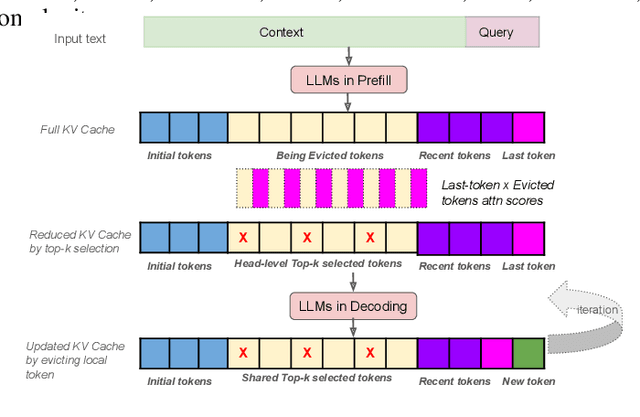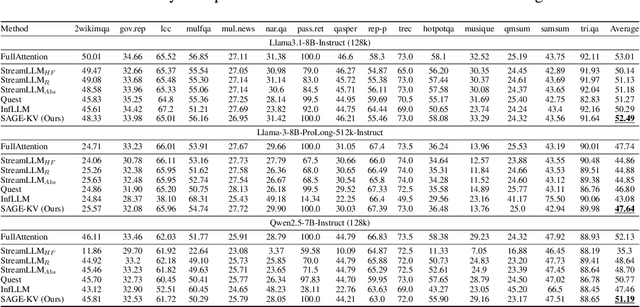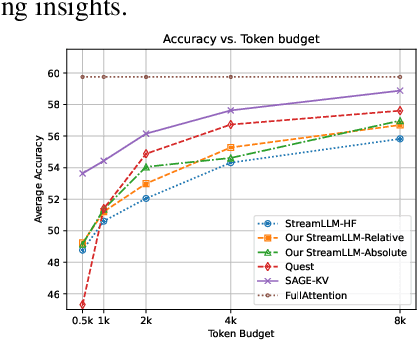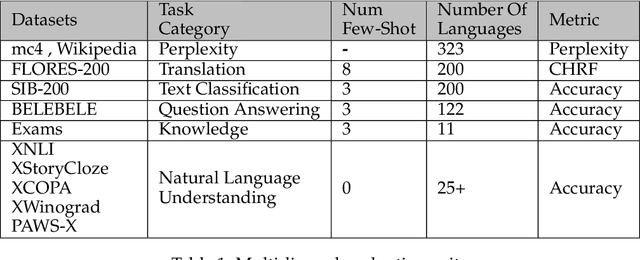Changran Hu
Agentic Context Engineering: Evolving Contexts for Self-Improving Language Models
Oct 06, 2025Abstract:Large language model (LLM) applications such as agents and domain-specific reasoning increasingly rely on context adaptation -- modifying inputs with instructions, strategies, or evidence, rather than weight updates. Prior approaches improve usability but often suffer from brevity bias, which drops domain insights for concise summaries, and from context collapse, where iterative rewriting erodes details over time. Building on the adaptive memory introduced by Dynamic Cheatsheet, we introduce ACE (Agentic Context Engineering), a framework that treats contexts as evolving playbooks that accumulate, refine, and organize strategies through a modular process of generation, reflection, and curation. ACE prevents collapse with structured, incremental updates that preserve detailed knowledge and scale with long-context models. Across agent and domain-specific benchmarks, ACE optimizes contexts both offline (e.g., system prompts) and online (e.g., agent memory), consistently outperforming strong baselines: +10.6% on agents and +8.6% on finance, while significantly reducing adaptation latency and rollout cost. Notably, ACE could adapt effectively without labeled supervision and instead by leveraging natural execution feedback. On the AppWorld leaderboard, ACE matches the top-ranked production-level agent on the overall average and surpasses it on the harder test-challenge split, despite using a smaller open-source model. These results show that comprehensive, evolving contexts enable scalable, efficient, and self-improving LLM systems with low overhead.
Distilling Tool Knowledge into Language Models via Back-Translated Traces
Jun 23, 2025Abstract:Large language models (LLMs) often struggle with mathematical problems that require exact computation or multi-step algebraic reasoning. Tool-integrated reasoning (TIR) offers a promising solution by leveraging external tools such as code interpreters to ensure correctness, but it introduces inference-time dependencies that hinder scalability and deployment. In this work, we propose a new paradigm for distilling tool knowledge into LLMs purely through natural language. We first construct a Solver Agent that solves math problems by interleaving planning, symbolic tool calls, and reflective reasoning. Then, using a back-translation pipeline powered by multiple LLM-based agents, we convert interleaved TIR traces into natural language reasoning traces. A Translator Agent generates explanations for individual tool calls, while a Rephrase Agent merges them into a fluent and globally coherent narrative. Empirically, we show that fine-tuning a small open-source model on these synthesized traces enables it to internalize both tool knowledge and structured reasoning patterns, yielding gains on competition-level math benchmarks without requiring tool access at inference.
LLMs Know What to Drop: Self-Attention Guided KV Cache Eviction for Efficient Long-Context Inference
Mar 11, 2025



Abstract:Efficient long-context inference is critical as large language models (LLMs) adopt context windows of ranging from 128K to 1M tokens. However, the growing key-value (KV) cache and the high computational complexity of attention create significant bottlenecks in memory usage and latency. In this paper, we find that attention in diverse long-context tasks exhibits sparsity, and LLMs implicitly "know" which tokens can be dropped or evicted at the head level after the pre-filling stage. Based on this insight, we propose Self-Attention Guided Eviction~(SAGE-KV), a simple and effective KV eviction cache method for long-context inference. After prefilling, our method performs a one-time top-k selection at both the token and head levels to compress the KV cache, enabling efficient inference with the reduced cache. Evaluations on LongBench and three long-context LLMs (Llama3.1-8B-Instruct-128k, Llama3-8B-Prolong-512k-Instruct, and Qwen2.5-7B-Instruct-128k) show that SAGE-KV maintains accuracy comparable to full attention while significantly improving efficiency. Specifically, SAGE-KV achieves 4x higher memory efficiency with improved accuracy over the static KV cache selection method StreamLLM, and 2x higher memory efficiency with better accuracy than the dynamic KV cache selection method Quest.
Training Domain Draft Models for Speculative Decoding: Best Practices and Insights
Mar 10, 2025Abstract:Speculative decoding is an effective method for accelerating inference of large language models (LLMs) by employing a small draft model to predict the output of a target model. However, when adapting speculative decoding to domain-specific target models, the acceptance rate of the generic draft model drops significantly due to domain shift. In this work, we systematically investigate knowledge distillation techniques for training domain draft models to improve their speculation accuracy. We compare white-box and black-box distillation approaches and explore their effectiveness in various data accessibility scenarios, including historical user queries, curated domain data, and synthetically generated alignment data. Our experiments across Function Calling, Biology, and Chinese domains show that offline distillation consistently outperforms online distillation by 11% to 25%, white-box distillation surpasses black-box distillation by 2% to 10%, and data scaling trends hold across domains. Additionally, we find that synthetic data can effectively align draft models and achieve 80% to 93% of the performance of training on historical user queries. These findings provide practical guidelines for training domain-specific draft models to improve speculative decoding efficiency.
SubgoalXL: Subgoal-based Expert Learning for Theorem Proving
Aug 20, 2024



Abstract:Formal theorem proving, a field at the intersection of mathematics and computer science, has seen renewed interest with advancements in large language models (LLMs). This paper introduces SubgoalXL, a novel approach that synergizes subgoal-based proofs with expert learning to enhance LLMs' capabilities in formal theorem proving within the Isabelle environment. SubgoalXL addresses two critical challenges: the scarcity of specialized mathematics and theorem-proving data, and the need for improved multi-step reasoning abilities in LLMs. By optimizing data efficiency and employing subgoal-level supervision, SubgoalXL extracts richer information from limited human-generated proofs. The framework integrates subgoal-oriented proof strategies with an expert learning system, iteratively refining formal statement, proof, and subgoal generators. Leveraging the Isabelle environment's advantages in subgoal-based proofs, SubgoalXL achieves a new state-of-the-art performance of 56.1\% in Isabelle on the standard miniF2F dataset, marking an absolute improvement of 4.9\%. Notably, SubgoalXL successfully solves 41 AMC12, 9 AIME, and 3 IMO problems from miniF2F. These results underscore the effectiveness of maximizing limited data utility and employing targeted guidance for complex reasoning in formal theorem proving, contributing to the ongoing advancement of AI reasoning capabilities. The implementation is available at \url{https://github.com/zhaoxlpku/SubgoalXL}.
SambaLingo: Teaching Large Language Models New Languages
Apr 08, 2024



Abstract:Despite the widespread availability of LLMs, there remains a substantial gap in their capabilities and availability across diverse languages. One approach to address these issues has been to take an existing pre-trained LLM and continue to train it on new languages. While prior works have experimented with language adaptation, many questions around best practices and methodology have not been covered. In this paper, we present a comprehensive investigation into the adaptation of LLMs to new languages. Our study covers the key components in this process, including vocabulary extension, direct preference optimization and the data scarcity problem for human alignment in low-resource languages. We scale these experiments across 9 languages and 2 parameter scales (7B and 70B). We compare our models against Llama 2, Aya-101, XGLM, BLOOM and existing language experts, outperforming all prior published baselines. Additionally, all evaluation code and checkpoints are made public to facilitate future research.
On the Tool Manipulation Capability of Open-source Large Language Models
May 25, 2023Abstract:Recent studies on software tool manipulation with large language models (LLMs) mostly rely on closed model APIs. The industrial adoption of these models is substantially constrained due to the security and robustness risks in exposing information to closed LLM API services. In this paper, we ask can we enhance open-source LLMs to be competitive to leading closed LLM APIs in tool manipulation, with practical amount of human supervision. By analyzing common tool manipulation failures, we first demonstrate that open-source LLMs may require training with usage examples, in-context demonstration and generation style regulation to resolve failures. These insights motivate us to revisit classical methods in LLM literature, and demonstrate that we can adapt them as model alignment with programmatic data generation, system prompts and in-context demonstration retrievers to enhance open-source LLMs for tool manipulation. To evaluate these techniques, we create the ToolBench, a tool manipulation benchmark consisting of diverse software tools for real-world tasks. We demonstrate that our techniques can boost leading open-source LLMs by up to 90% success rate, showing capabilities competitive to OpenAI GPT-4 in 4 out of 8 ToolBench tasks. We show that such enhancement typically requires about one developer day to curate data for each tool, rendering a recipe with practical amount of human supervision.
Programming Language Agnostic Mining of Code and Language Pairs with Sequence Labeling Based Question Answering
Mar 21, 2022



Abstract:Mining aligned natural language (NL) and programming language (PL) pairs is a critical task to NL-PL understanding. Existing methods applied specialized hand-crafted features or separately-trained models for each PL. However, they usually suffered from low transferability across multiple PLs, especially for niche PLs with less annotated data. Fortunately, a Stack Overflow answer post is essentially a sequence of text and code blocks and its global textual context can provide PL-agnostic supplementary information. In this paper, we propose a Sequence Labeling based Question Answering (SLQA) method to mine NL-PL pairs in a PL-agnostic manner. In particular, we propose to apply the BIO tagging scheme instead of the conventional binary scheme to mine the code solutions which are often composed of multiple blocks of a post. Experiments on current single-PL single-block benchmarks and a manually-labeled cross-PL multi-block benchmark prove the effectiveness and transferability of SLQA. We further present a parallel NL-PL corpus named Lang2Code automatically mined with SLQA, which contains about 1.4M pairs on 6 PLs. Under statistical analysis and downstream evaluation, we demonstrate that Lang2Code is a large-scale high-quality data resource for further NL-PL research.
Generating Code with the Help of Retrieved Template Functions and Stack Overflow Answers
Apr 13, 2021



Abstract:We approach the important challenge of code autocompletion as an open-domain task, in which a sequence-to-sequence code generator model is enhanced with the ability to attend to reference code snippets supplied by a semantic code search engine. In this work, we present a novel framework to precisely retrieve template functions as well as intent-snippet pairs and effectively train such a retrieval-guided code generator. To demonstrate the effectiveness of our model designs, we perform extensive experiments with CodeSearchNet which contains template functions and CoNaLa which contains Stack Overflow intent-snippet pairs. We also investigate different retrieval models, including Elasticsearch, DPR, and our fusion representation search model, which currently holds the number one spot on the CodeSearchNet leaderboard. We observe improvements by leveraging multiple database elements and further gain from retrieving diverse data points by using Maximal Marginal Relevance. Overall, we see a 4% improvement to cross-entropy loss, a 15% improvement to edit distance, and a 44% improvement to BLEU score when retrieving template functions. We see subtler improvements of 2%, 11%, and 6% respectively when retrieving Stack Overflow intent-snippet pairs. We also create a novel Stack Overflow-Function Alignment dataset, which consists of 150K tuples of functions and Stack Overflow intent-snippet pairs that are of help in writing the associated function, of which 1.7K are manually curated.
 Add to Chrome
Add to Chrome Add to Firefox
Add to Firefox Add to Edge
Add to Edge